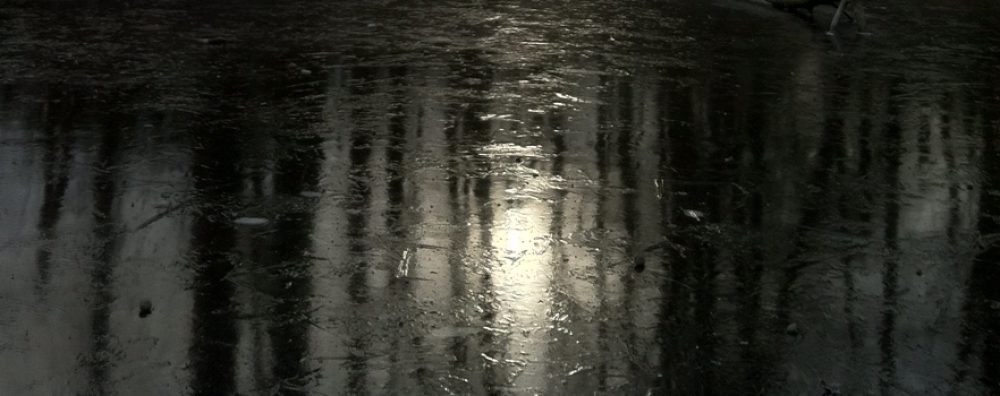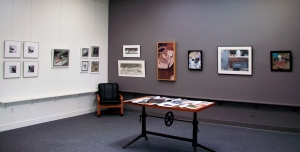“Exploring Altered States with David Brody
David Brody’s Art is Surreal and Psychedelic”
by Emily Manke, Culture Magazine, October 1, 2015
To read the interview and article: http://ireadculture.com/exploring-altered-states/
“Observing Observing (a white cup)”
A Conversation with the Curators: Thursday, October 15, 2015, 7pm
“How does observation play into form and expression?”
In their conversations together, curators Michael Howard and Norman Lundin came up with some additional related questions for the artists to think about.
Artist, Matt Klos, who resides in Maryland, sent us his responses:
Q – “What did it mean to successfully respond to this project?”
I’m always sort of working with objects that are somewhat “blank” in nature… like the white cup. Normally my subject is comprised of complex studio interiors which differs from the white cup significantly, in one way, but is very much like the white cup in the anti-monumentality of what I’m choosing to depict. The project gave me an excuse to hone in on a more traditional still life which I like to do but have gotten away from over the years. My still lifes normally deal with so much of the internal space of an area that they are really best understood as interiors.
Q – “In your drawing/photography/painting, what does it mean for your work to succeed?”
MK: I normally start simple with a particular idea or approach. In “Diagonal” I wanted to make a painting that told the tale of the particular light that filtered through the basement window into my studio on summer afternoons. The colors that the light revealed were all mid-tone and all lights and darks were held closely together. I did my best to maintain that nearness while still describing the solidity of the forms within the still life. The success of the color scheme was really surprising.. I mean, who knew that ochre brown, teal, and violet could look so good together! Also, I did a fair amount of arranging the surface in this particular painting. If you put a crosshairs over the painting you’ll perfectly bisect the painting along both vertices. Although i was working directly from observation the objects were moved about to fit a particular construct. The description of aspects of the interior were quite important too. There is a tiny tack head which is divided by a slight reflection which holds the upper left of the composition and things like this move the attentive viewer through the composition. These bits of extreme detail are offset by gauzy merely alluded to areas.
Q – “How do you understand form in relation to expressing your observational experience?” /or/ “How would you describe the form created by representing your perceptual experience?”
MK: The form, or formal geometrical underpinning of painting, is integral. Although depth is the alluring and magical aspect of painting it’s the geometry that all great paintings rely upon. Both of my paintings for this exhibition are meant to be centrally anchored with intrigue in both color and shape allow for a cyclical reading of the work.
Q – “What can you tell us about the expressive results (the expression) of your observational experience?” /or/ “What part does expression play in your work?”
MK: Expression for me is both an end and a means. I paint due to a sort of compulsion or urge. I’ve heard some refer to this as eroticism and I guess it is although only in the sense that you are mitigating the fever of creativity and trying to keep it from spilling over. You want to keep all of that excitement and affection in the work. Living in that state of tension is what allows for the other end of expression to be seen in the work. If I’ve done the painting the way I’ve wanted there is always a sort of vibrating excitement and nimble attention to things.
The essay, “The Fickle Angel” by Norman Lundin, written as the introduction for the upcoming book, “The Elements of Landscape Oil Painting”, by Suzanne Brooker. (The essay is slightly modified from the one that is published in the book.)
The painting reproduced in this book, Across Beaver Creek, is an earlier version of a painting now much changed. One can still see, however, the early bits in the final version.
As subject matter, landscape is a forgiving genre; one can greatly change color, shapes and forms and still have a verisimilitude to a given scene. While I believe in thinking “abstractly” while painting “descriptively”, it is my intent to “convince” with my imagery. My traditional descriptive skills are reasonably good; however, I do not hesitate to make up imagery, move trees, buildings, hills, and change scale to achieve a certain “abstract” whole. So, while my overall painting has changed in form, my intent to evoke a sense of place and time has not.
Intent, both in form and expression, is important to the artist. However, intent alone, however serious, does not make good painting (one should keep in mind that most bad art is created by those who have serious intent). Good ideas and serious intent aren’t accomplishment. By themselves they are not important.
Serious intent may be taken as a “ given”; what is important here is how ideas are painted. Nothing else counts, if it is not well painted, then trash it (regardless of how good the idea). Everything one does is at the service of the painting. I believe the painting, “the thing itself,” must succeed as a physical entity, independent and regardless of whatever other concerns may be in attendance.
So, from my end, the problem was and is, that of form (expressiveness, I just leave alone, it must come on it’s own, best not even to think about it). So, for me, the best approach is to set myself visual problems then solve them. The painting Across Beaver Creek had pretty good form but wasn’t right for me. Hard to explain, but all artists know the feeling. Good and correct form doesn’t necessarily make good painting. That is the problem – if a work is successful in all its formal components and just sits there, for god’s sake, you cannot leave it at that; you haven’t gone far enough
Of course you don’t know how far “far enough” is until you’ve gone too far, a formidable problem. But you must do something, after you’ve tried everything you know, the “desperation measure” comes to mind (in the short run, try to resist putting your foot through the canvas – that part come later). What you do is throw in something very different from your approach so far. Sometimes this approach will work — not often though. But, when it does work, you’ve learned something and have moved ahead as an artist. I tried the desperation approach with this one (took out the creek, made a screen of trees across the foreground and changed the color of the fields). As a painting I think now it succeeds as “the thing itself.” It is hard to tell, though, I’m still too close in time to see it objectively. I’ll know in a couple months.
This “desperation approach” is a messy process (literally, figuratively). When it doesn’t succeed, (mostly it doesn’t, it is desperate after all, but still…) I throw the painting away. This is where “putting your foot through the canvas” part comes in. I am a big believer in throwing away paintings, even those that have successful form, especially those that just sit there. It is essential to learn to separate effort from accomplishment.
In painting one must have ideas and occasional luck (with or without the desperation attached). Ideas, skill, and luck may align themselves and your painting succeeds. But, for things to succeed, as Wallace Stevens wrote, you occasionally need the “Necessary Angel.” That angel may start out sitting on your shoulder, your painting goes wonderfully, then it starts to go bad — you look to your shoulder and find that your angel has gone out for a pizza and a beer. Sometimes she returns and the painting succeeds, sometimes she doesn’t. Angels tend to be fickle. -Norman Lundin
The book, published by Watson-Guptill, will be released 8/8 and also includes the work of Prographica artist, Kimberly Clark








